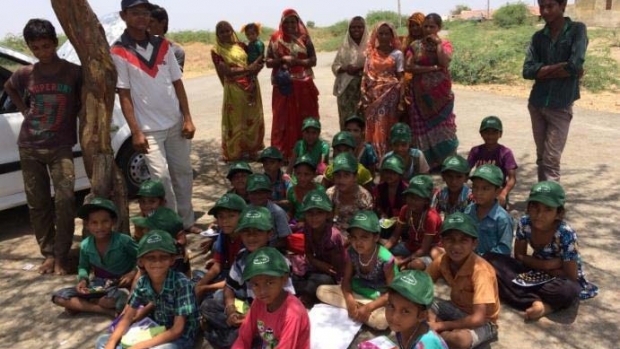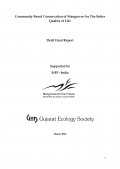Grants :: Small Grant Facilities :: Community Based Conservation of Mangroves for The Better Quality of Life
Community Based Conservation of Mangroves for The Better Quality of Life

Communities work together to catalog biodiversity in and aro ... , South Gujarat © GES, 2015
Objectives
- Creation of Biodiversity management committees in villages
- Education and Create awareness of communities in villages on mangrove conservation and its benefits to the coastal environment and livelihood
- Equal opportunities provided for men and women for supplementary livelihoods’
Background
There is growing public awareness of the conservation and rehabilitate the degraded mangrove wetlands. This awareness is growing among coastal communities, particularly because of severe storms, coastal erosion and increased awareness on linkages between mangrove and sustainable fisheries. The propagation and planting of mangrove trees is mainly done by Forest Departments. The department is involving local communities in the raising of nurseries and plantations activities mainly on turnkey basis. It is felt that involvement of locals at the sage of decision making and planning will give them sense of owner ship and make them more responsible for success of the plantation efforts. Proactive participation will also locals them alternative livelihood option.
Bharuch (also known as ‘Broach’) is a district in the southern part of Gujarat peninsula on the west coast of the state and lies between 21°51’ North latitude and 73°01’ East longitude. The climate of the district is by and large hot and dry in summers and cold in winters. It receives maximum rainfall during the monsoon period. The monsoon in this district is generally accompanied by dusty winds. Geologically, the district is mainly composed of Alluvium, blown sand, etc. The soils of the district are mainly sandy loan and black type. Agriculture is the main occupation and cotton. Jowar, rice, bajri, tobacco and groundnut are principal crops in the district. The region also known as “bara tract” experiences very high soil salinity along with high salinity and high fluoride in ground water. This indicates domination of marine processes in the region. The presence mangrove are very critical for the shoreline stability as a study by ISRO (2001) on coastal have recorded that the area suffered erosion at the rate of 5m/year. This has exposed the locals to salinity ingress and coastal erosion.
The population residing in the area is very poor with large number of people are agriculture laborer. Presence of mangrove in coastal areas plays vital role in protecting shore from erosions and salinity ingress. They are also important source of livelihood as the villagers of the study area are dependent on mangrove as fodder, food and for fisher ground. Also fish mainly mudskipper, and Prawn/Shrimp is the important food for villages. Mangrove and fish play important role in their economy.
The mangrove habitat is under heavy pressure due to its collection of leaves and seeds for fodder, which has slowed down the natural regeneration capacity of mangroves. Plantation efforts were done in the past, however due to lack of proper protection and institutional setup the region suffered heavy degradation. The present study was carried out the 3 coastal villages of Jambusar viz., Muradpor- Neja, Zamdi and Chhidra. These coastal villages form the eastern bank of the Gulf of Khambhat. The coast is located between the estuarine region of Mahi R and Dhadhar R. With average tidal amplitude of 4 m, the maximum tides of 8 m are being experienced by the region.
Being coastal plains the altitude hardly exceed 10 meter (AMSL) in the region. The mangrove is located mainly 3-4 m amsl. Being inner the Gulf the bathymetry is very shallow mostly less than 10 m. With annual rainfall of 800 to 900 mm and annual average temperature of 21°C (minimum) to 36°C (maximum), the region experience semiarid climate. As per 2011 census the villages mainly consist of by agriculture dependent communities, dominated by labors.
Target beneficiaries
- Local coastal communities of Zamdi, Chidra and Neja villages
- The State Biodiversity Board
Outputs
People's Biodiversity Registers were developed with all 3 villages, and the PBR committees registered with the Gujarat State Biodiversity Board. The committees were capacity built to identify, and carry out conservation activities with the funds they will be given by the Board.
Accomplishments and challenges
The data suggest village Neja is relatively better in agro and wild diversity. Wild species of economic importance was also recorded from Chidra which included 43 medicinal plants, 5 crop relatives, 20 wild ornamental plants and 5 timber species. Similarly Zamdi village reported 40 medicinal plants, 5 crop relatives, 11 wild ornamental plants and 4 timber species, 9 and 33 coastal and marine flora and fauna. Neja recorded 50 medicinal plants, 5 crop relatives, 23 wild ornamental plants and 6 timber species, 9 and 40 coastal and marine flora and fauna. The status of the biodiversity provides opportunities for provision of supplementary livelihoods for the local communities.
Contributions to cross-cutting themes
Mangroves are increasingly being recognized for the various services they offer humankind. This project aims to raise awareness amongst local communities of the importance of mangroves.
Lessons Learned
- Villagers do take part in various activities related to mangrove conservation, with a primary goal is to earn some livelihood during lean period.
- Children living close to coast are more linked to activities of fishing and understand mangrove better than those who stay 8-10 km away.
- Women do take part in mangrove plantation for creating nursery.
- Increase aquaculture may replace traditional fishery in future.
- In Gujarat recent increase in mangrove cover is mainly due to active participation of communities in afforestation drive. Though the fisherman accept that mangroves are good for fishery, they believes that other factors are becoming more dominant, like increase in industrial pollution has adversely affected fishery.
Project Facts
Country
Location
South Gujarat, India
Topic
Duration
15th Dec 2014 to 15th Jan 2016
MFF Grant Amount
INR 945,700
Co-financing Partner
GES - INR 160,930
Implementing Partner
Dr. Jayendra Lakhmapurkar
Deputy Director, Gujarat Ecological Society
Related Publications

Community Based Conservation of Mangroves for The Better Quality of Life
Author: GES
Publisher: IUCN
Posted on: 12th May 2016
Category: SGF (Small Grant Facility)
Size: 5.7 MB